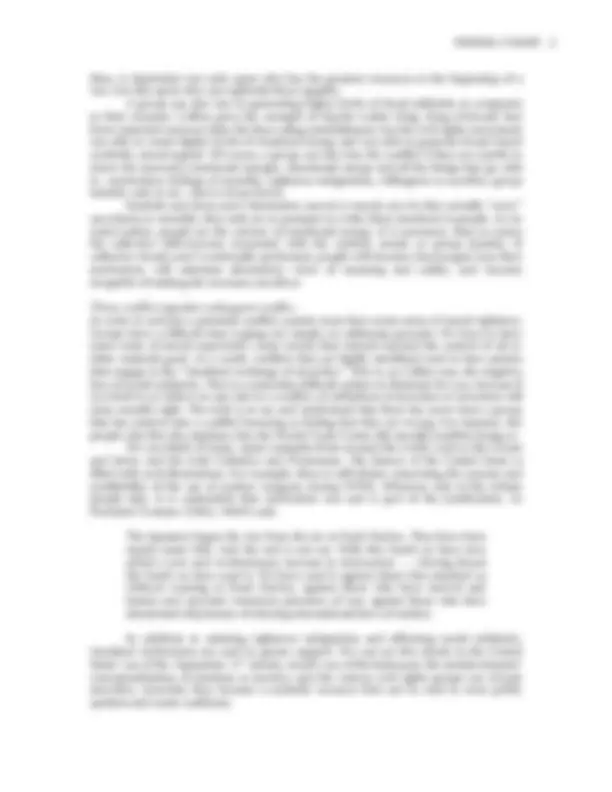






Study with the several resources on Docsity

Earn points by helping other students or get them with a premium plan


Prepare for your exams
Study with the several resources on Docsity

Earn points to download
Earn points by helping other students or get them with a premium plan
Community
Ask the community for help and clear up your study doubts
Discover the best universities in your country according to Docsity users
Free resources
Download our free guides on studying techniques, anxiety management strategies, and thesis advice from Docsity tutors
Explain in weber and conflict theory, structural conflict theory history in sociology
Typology: Lecture notes
1 / 8

This page cannot be seen from the preview
Don't miss anything!





Conflict theory has a long history in sociology. Without question, Karl Marx’s work in the early to mid-1800s formed the initial statements of this perspective. As you know, Marx was centrally concerned with class and the dialectics of capitalism. He argued that capitalism would produce its own gravediggers by creating the conditions under which class consciousness and a failing economy would come into existence. In this juncture between structure and class-based group experience, the working class revolution would take place. In the early 20th^ century, Max Weber formulated a response to Marx’s theory. Weber saw that conflict didn’t overwhelmingly involve the economy, but that the state and economy together set up conditions for conflict. Of central importance to Weber’s scheme is the notion of legitimation. All systems of oppression must be legitimated in order to function. Thus, one of the critical issues in the question of conflict is legitimation. Weber also saw that class is more complex than Marx initially supposed, and that there are other factors that contribute to social inequality, most notably status and party (or power). Since that time a number of efforts have been made to combine different elements from one or both of these theorists to understand conflict. One of the most notable efforts in this vein is that of Randall Collins. In 1975 Collins published Conflict Sociology. His goal in the book was to draw together all that sociology had learned about conflict and to scientifically state the theories in formal propositions and hypotheses. The end result is a book that contains hundreds upon hundreds of such statements. Without a doubt this book represents the most systematic effort ever under taken to scientifically explain conflict. My reason for beginning this Web Byte with an academic review isn’t to heap praises on Collins. But, rather, I want to contextualize what you’re about to read. In 1993, Collins reduced the hundreds of theoretical statements from his 1975 work to just “four main points of conflict theory” (p. 289). Anytime a theorist does something like this, the end statement is theoretically powerful. In essence what Collins is saying is that most of what we know about conflict can be boiled down to these four points.
To get to this kind of statement, Collins (1975) draws on the work of Weber, Durkheim, and Goffman to argue that symbolic goods and emotional solidarity are among the “main weapons used in conflict” (p. 59). This is a unique and powerful addition to the conflict perspective. Most conflict theories are oriented toward the macro-level. Stratification is generally understood as operating through oppressive structures that limit access and
choices (the idea of the “glass ceiling” is a good example); and power is conceived of as working coercively through the control of material resources and methods of social control. Collins, on the other hand, lets us see that the conflict around stratified resources has a strong symbolic character. Resources aren’t simply material. Both stratification and conflict require symbolic supplies and emotional investment in order to work. Collins also attunes us to a different side of conflict. Conflict doesn’t just happen between warring factions. Conflict is dependent upon and occurs in subtle forms within the realm of face- to-face interactions and rituals. Collins also sensitizes us to a different mode of conflict: the internalization of symbolic meanings expressed through belief in accepted legitimations.
One: the unequal distribution of each scarce resource produces potential conflict between those who control it and those who don’t. The basic outlines of the three types of scarce resources are given by Weber: economic resources, which may be broadly understood as all material conditions; power resources, which are best understood as social positions within control or organizational networks; status or cultural resources, which Collins understands as control over the rituals that produce solidarity and group symbols.
Two: potential conflicts become actual conflicts to the degree that opposing groups become mobilized. There are at least two main areas of mobilization: The first is emotional, moral, and symbolic mobilization. The prime ingredient here is collective rituals. This is one of Collins’s main contributions to conflict theory. Groups don’t simply need material goods to wage a battle; there are also clear emotional and symbolic goods. As Durkheim says (1912/1995), “we become capable to feelings and conduct of which we are incapable when left to our individual resources” (p. 212). The more a group is able to physically gather together, create boundaries for ritual practice, share a common focus of attention, and common emotional mood (see Chapter 5), the more group members will
The second main area for mobilization concerns the material resources for organizing. Material mobilization includes such things as communication and transportation technologies, material and monetary supplies to sustain the members while in conflict, weapons (if the conflict is military), and sheer numbers of people. While this area is pretty obvious, the ability to mobilize material resources is a key issue in geopolitical theory, which we consider in the last part of this Web Byte. There are a couple of corollaries or consequences that follow these propositions. If there are two areas of mobilization, then there are two ways in which a party can win or lose a conflict. The material resources are fairly obvious. Material resources get used up during conflicts. People die, weapons are spent, communication and transportation technologies are used up, break down, or are destroyed, and so on. A conflict outcome,
Four: conflicts diminish as resources for mobilization are used up. Just as there are two main areas of conflict mobilization, there are two fronts where demobilization occurs. For intense conflicts, emotional resources tend to be important in the short-run, but in the long-run material resources are the key factors. Many times the outcome of a war is determined by the relative balance of resources. Collins gives us two corollaries. One, milder forms of conflict tend to go on for longer periods of time than more intense ones. Fewer resources are used and they are more easily renewed. This is one reason why terrorism and guerilla warfare tend to go on almost indefinitely. Civil rights and relatively peaceful political movements can be carried out for extended periods as well. Two, relatively mild forms of conflict tend to deescalate due to bureaucratization. Bureaucracies are quite good at co-optation. To co-opt means to take something in and make it part of the group, which on the surface might sound like a good thing. But because bureaucracies are value and emotion free, there is a tendency to down play differences and render them impotent. For example, one of the things that our society has done with race and gender movements is to give them official status in the university. One can now get a degree in race or gender relations. Inequality is something we now study, rather than the focus of social movements. In this sense, these movements have been co- opted. “This is one of the unwelcome lessons of the sociology of conflict. The result of conflict is never the utopia envisioned in the moments of intense ideological mobilization; there are hard-won gains, usually embedded in an expanded bureaucratic shell” (Collins, 1993, p. 296). The second front where conflicts may be lost is deescalation of ritual solidarity. A conflict group must periodically gather to renew or create the emotional energy necessary to sustain a fight. One of the interesting things this implies is that the intensity of conflicts will vary by focus of attention. Conflict that is multifocused will tend not to be able to generate high levels of emotional energy. The conflict over civil rights in the United States is just such a case. The civil rights movement has splintered because the idea of civil rights isn’t held by everyone involved as a universal moral. That is, the groups involved don’t focus on civil rights per se ; they focus on civil rights for their group. For example, there are those working for the equal rights of African Americans who would deny those same rights to homosexuals.
There are two things that I want to point out before we consider geopolitical theory. The first is that geopolitical processes happen over the long-run. These forces take time to build up and aren’t readily apparent, especially to most of us living in the United States. In this country we have difficultly thinking in the long-term. We are focused on the individual and immediate gratification, and even the economic planning that is done is oriented toward short-term portfolio management. Geopolitical theory is sociology in the long-run. It explains how nations grow and die. The processes and dynamics can’t be seen by just looking at our daily concerns. We have to rise above our self and look historically. The second thing I want to point out is that geopolitical theory focuses on the state rather than the economy. Generally speaking, world-systems theories, like that of Immanuel Wallerstein (Chapter 9), focus on the economy. Collins understands the world system in more Weberian terms, where the nation-state is the key actor on the world stage. Nation-states are relatively recent inventions. Up until the sixteenth century the world was not organized in terms of nation-states. People were generally organized ethnically with fairly fluid territorial limits, as with feudalism. Feudalistic states were based on land stewardship established through the relation of lord to vassal. Its chief
characteristics were homage, the service of tenants under arms and in court, wardship, and forfeiture. A nation-state, on the other hand, is a collective that occupies a specific territory, shares a common history and identity, is based on free-labor, and sees itself as sharing a common fate.
In Weberian terms, the state is defined as exercising a monopoly over the legitimate use of force within and because of a specific geographic territory. First and foremost, nation- states have a monopoly on force. In fact, one of the main impetuses behind the nation is the ability to regularly tax people for the purpose of creating a standing army. Previously, armies were occasional things that were gathered to fight specific wars. A standing army is one that is continually on standby; it is ready to fight at a moment’s notice. Notice that nation-states are organized around the legitimate use of power. Thinking about power in terms of legitimacy brings in cultural and ritual elements. If power is defined as the ability to get people to do what you want, then legitimacy is defined in terms of the willingness of people to do what you want. In order for any system of domination to work, people must believe in it. Part of the reason behind this need is the cost involved in the use of power. If people don’t believe in authority to some degree, they will have to be forced to comply through coercive power. The use of coercive power requires high levels of external social control mechanisms, such as monitoring (you have to be able to watch and see if people are conforming) and force (because they won’t do it willingly). To maintain a system of domination not based on legitimacy costs a great deal in terms of technology, money, and manpower. Additionally, people generally respond in the long-run to the use of coercion by either rebelling or giving up—the end result is thus contrary to the desired goal. Authority and legitimacy, on the other hand, imply the ability to require performance that is based upon the performer’s belief in the rightness of the system. With nation-states there is an interesting relationship between force and legitimacy. According to Collins (1986), this legitimacy is a special kind of emotion: it’s “the emotion that individuals feel when facing the threat of death in the company of others” (p. 156). Legitimacy isn’t something that is the direct result of socialization, though it plays a part. Rather, legitimacy is active; it ebbs and flows and is stronger at some times than others—people feel more or less patriotic depending on a number of factors, most notably ritual performance. The governments of nation-states are painfully aware of the active nature of legitimacy. Legitimacy provides the government’s right to rule. Though also associated with economic prosperity and mass education, nationalism, the nation-state’s particular kind of legitimacy, is dependent upon a common feeling that is most strongly associated with ritualized interactions performed in response to perceived threat. This threat can be internal, as in the case of minority group uprisings, crime, and deviance, but it is most strongly associated with externally produced threat and shock. The other defining feature of the nation-state is the control of a specific geographic territory. One of the reasons that a standing army came about was to defend a specific territory. As humans first became settled due to agriculture, it became increasingly necessary to defend the territory and internally organize a population that was increasing in both size and diversity. The geographic contours of this territory are extremely important for Collins, both in terms of geopolitical theory and his micro- macro link. Collins (1987) argues that the idea of property “upholds the macroworld as a social structure” (p. 204). The reason behind this is that property is the fundamental backdrop against which all interaction rituals are produced. Further, geographic space is
The expansion began with Moscow, a small state with a marchland advantage. Fighting fragmented rivals, Moscow made slow cumulative growth. By 1520, Moscow had annexed all of ethnic Russia. By the late 1700s, Russia had expanded across Siberia and the Southern Steppes and was a strong military power in Europe. Russia further expanded by taking advantage of Napoleon’s wars, the fall of the Ottoman Empire, and China’s prolonged civil wars—this further expansion was based on geopolitical factors. In the end, the USSR was the largest country on the globe, consisting of 15 soviet socialist republics whose territories reached from the Baltic and Black seas to the Pacific Ocean, an area of 8,649,512 square miles, eleven time zones, and, most importantly, sharing common boundaries with six European countries and six Asian countries. Knowing geopolitical issues, the problems facing the USSR are obvious. The nation was overextended both culturally and economically. It no longer held heartland advantage: in terms of total population, the enemies of the USSR outnumbered them 3. to 1; and in terms of economic resources, it was 4.6 to 1. Additionally, because of its successful expansion, the USSR no longer had a marchland advantage. It had done away with all weak buffer states and only faced powerful enemy nations in all directions. Further, the USSR had to exert militarily control over its Eastern European satellites, which were two and three times removed from the heartland. All told, it had to defend borders totally 58,000 kilometers, or over 36,000 miles. Additionally, the USSR contained at least 120 different ethnic groups. As Collins (1986) projected, “if Russia has shifted from a marchland to an interior position, it may be expected that in the long-term future Russia will fragment into successively smaller states” (p. 196).
Collins, R. (1975). Conflict sociology. New York: Academic Press.
Collins, R. (1986). Weberian sociological theory. New York: Cambridge University Press.
Collins, R. (1987). Interaction ritual chains, power and property: The Micro-macro connection as an empirically based theoretical problem. In J. C. Alexander, B. Giesen, R. Münch, and N. J. Smelser (Eds.) The Micro-macro link. Berkeley: University of California Press.
Collins, R. (1993). What does conflict theory predict about American’s future? 1993 presidential address. Sociological Perspectives , 36: 289 – 313.
Durkheim, É. (1995). The elementary forms of the religious life (K. E. Fields, Trans.). New York: Free Press. (Original work published 1912)
Collins, R. (2004). Interaction ritual chains. Princeton: Princeton University Press.
Truman, H. S. (1945a). Statement by the President announcing the use of the A-Bomb at Hiroshima. Retrieved August 1, 2004 from http://www.trumanlibrary.org/publicpapers/index.php?pid=100&st=&st1=
Truman, H. S. (1945b). Radio report to the American people on the Potsdam Conference. Retrieved August 1, 2004 from http://www.trumanlibrary.org/publicpapers/index.php?pid=104&st=&st1=